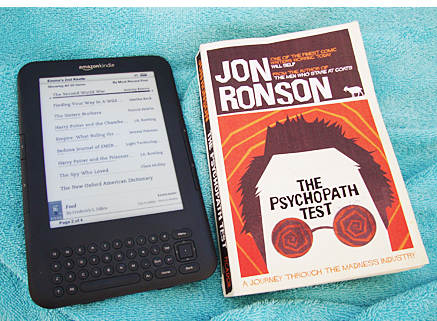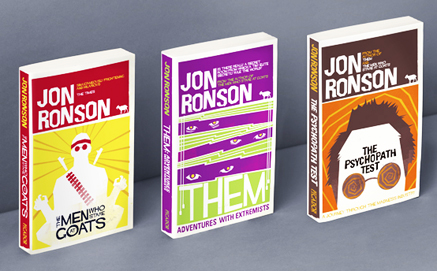 As you can see, I’ve just come back from holiday.
As you can see, I’ve just come back from holiday.
And for the first time, I took a Kindle. (Although I did panic at the airport and bought a couple of paper books, ‘just in case’) The differences between ebooks and paper books are pretty self evident, David Hepworth’s views on the matter are well worth revisiting, but for me, the comparison was a new experience. Digital books and digital magazines may be very different propositions, but for both of them, the dilemma over what constitutes a ‘cover’ remains.
 A book cover sets up some measure of expectation. It contains a massive amount of information about what the reading experience is likely to be. I picked out Jon Ronson’s book at WH Smith, on the basis that I had a couple of recomendations, but they were only triggered after I saw the book on the shelf. But if I knew nothing about the book, the design still has enough information to let me understand the quirky, contemporary nature of the work. And for those who’ve read his other books, there’s the straightforward issue of brand recognition. Much like a magazine cover.
A book cover sets up some measure of expectation. It contains a massive amount of information about what the reading experience is likely to be. I picked out Jon Ronson’s book at WH Smith, on the basis that I had a couple of recomendations, but they were only triggered after I saw the book on the shelf. But if I knew nothing about the book, the design still has enough information to let me understand the quirky, contemporary nature of the work. And for those who’ve read his other books, there’s the straightforward issue of brand recognition. Much like a magazine cover.
An ebook is another thing entirely. I bought several on the way to the airport, on the same basis of a couple of recommendations. Being able to buy on the fly was a fantastic utility, but I didn’t have to go through the emotional experience of seeing the cover before I bought. Which made my level of engagement with the books significantly less.
So I found myself reading several simultaneously, all the while constantly checking the percentage read icon, as opposed to just ‘feeling’ how much of a paper book I had read.
All of which gives me the idea that the way ebooks are written will change. Not only do they not have a cover, if read on a tablet they are only one click away from angry birds. Engagment at the outset is less, distraction through the experience is much greater. Books will become shorter, snappier, and requiring of much less effort.
For what it’s worth, the ebooks I was/am reading are: The Second World War by Anthony Beevor (42% read). Thinking Fast and Slow by Daniel Kahnman (82% read) and Inspired: How To Create products Customers Love by Marty Cagan (100% read)
All are terrific, but Marty’s was the shortest!